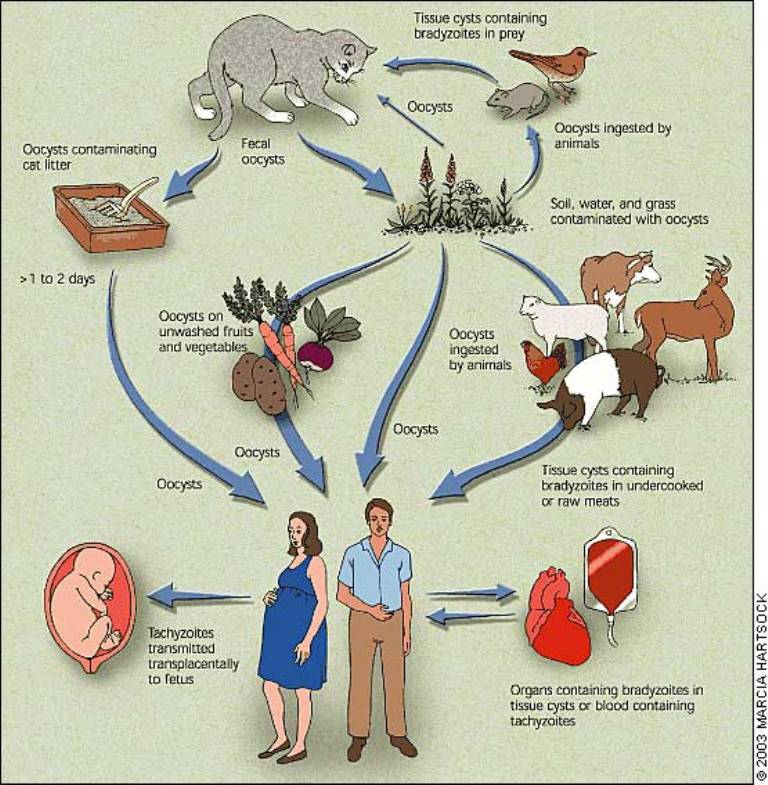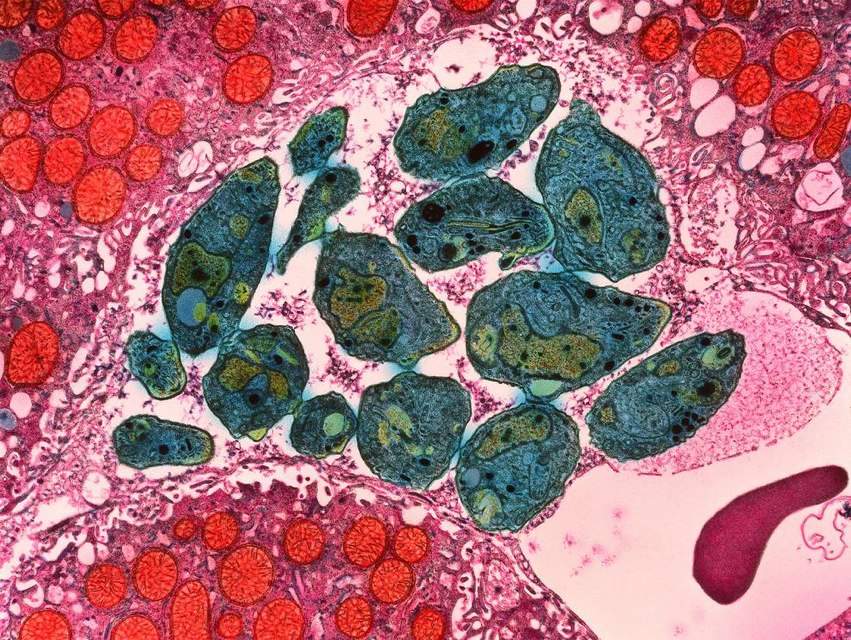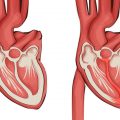Content:
- How do you get infected
- How is toxoplasmosis
- What are the symptoms of toxoplasmosis
- Diagnostics
- How to cure a toxoplasmosis
- The consequences of toxoplasmosis
Toxoplasmosis - a disease, caused by a parasite called Toxoplazma gondii. The disease can cause irreversible changes in all organs and human systems, but can also proceed without any complications, and does not disturb the person. To prevent the development of dangerous pathologies, must be able to identify the symptoms of toxoplasmosis, time to start treatment and to comply with special preventive measures.

How do you get infected
Parasites form Toxoplazm Gondy may enter the human body in several ways:
- through animals (after contact with animals carrier parasites);
- through products (eating unwashed fruits and vegetables, poorly processed meats);
- By insect bites or open wounds on the skin;
- Through intrauterine infection (from the mother - child);
- Organ transplant or blood transfusion.
Important! The main route of transmission of parasites Toxoplazm gondii - contaminated food. Through the mucous membranes and open wounds, infection occurs less often.
Most of all, toxoplasmosis is common in warm (southern) regions. The risk of infection with toxoplasmosis people, which are connected with the source of infection due to profession (livestock farms, veterinary clinics, meat packing plants).
note! The most common route of infection toxoplasmosis - contact with pets, especially with cats.
In the body, pet parasites can be a long time, grow and multiply. Pathogens are excreted in urine, saliva and faeces into the environment. Therefore it is necessary to observe personal hygiene when caring for pets (especially when the toilet cleaning pets).

How is toxoplasmosis
Getting first in the human intestine, toxoplasmosis pathogen is rapidly spreading throughout the body through the blood and lymph nodes. In the blood, the parasite can persist for a few days, so he "settles" on the viscera tissues.
If a person has a strong immune system, the pathogen can not multiply in the body and forms a so-called tissue cysts. They may persist in the body for decades, without causing any functional disorders. This form of toxoplasmosis requires no treatment, asymptomatic, and its support is estimated, as a healthy man.
But with reduced immunity parasites are beginning to multiply and cause inflammation of all organs, which leads to malfunction of the nervous, cardiovascular and other body systems. Some patients have indolent toxoplasmosis, in which symptoms do not manifest themselves practically. But there are severe forms of the disease, requiring immediate diagnosis and treatment.
Depending on the route of infection of toxoplasmosis in humans is divided into two main forms:
- congenital form. classified, If the infection occurs in the womb. The disease affects the brain, and because toxoplasmosis of the brain characterized by severe and can be fatal.
- The acquired form. More mild form of the disease, notes long incubation period and the subsequent manifestation of symptoms.
Acquired toxoplasmosis is divided in turn into 3 species, depending on the severity of the:
- acute toxoplasmosis;
- chronic toxoplasmosis;
- Latentnыy kind.
For most people, toxoplasmosis occurs in the latent and chronic, Symptoms do not occur at the same time. The acute form is rare - usually in people with weak immune systems, related to the relevant disease (HIV infection, viral disease, oncology).
Important! During normal operation of the immune system in the human body develop antibodies to Toxoplazm Gondi and creates a lifetime immunity to toxoplasmosis.

What are the symptoms of toxoplasmosis
The clinical picture of toxoplasmosis is very diverse, tk. symptoms depending on the type and form of the disease.
congenital toxoplasmosis
In the acute phase of congenital toxoplasmosis disease affects all systems and organs , because showing signs of total destruction of the body:
- Temperature rise;
- Reduced muscle tone;
- manifestations of jaundice;
- Lethargy, chills;
- Skin rash;
- The increase in size of the liver and spleen.
When, If the inflammatory process, caused by toxoplasmosis, It does not hit around the body at the same time, and affects only certain parts of it may develop strabismus, disturbances in the brain, blindness.
Acquired acute toxoplasmosis
Symptoms of acute forms in adults are similar to the symptoms of typhoid and start immediately with the appearance of seizures, temperature increase, vomiting, rash, pneumonia. These displays other signs of toxoplasmosis can join over time:
- Chills, frequent fatigue;
- swollen lymph nodes (usually in the neck);
- Articular and headache, muscular weakness;
- Encephalitis;
- Increased spleen or liver, hepatitis;
- inflammation of the retina, eye cataract.
The acute form usually lasts less than a week, and then it goes into a latent (or chronic) form.
Acquired chronic toxoplasmosis
after 2-3 Time from infection begin to manifest symptoms of chronic toxoplasmosis, the most common form of the disease. It can occur latently, without showing symptoms themselves, many years.
Chronic toxoplasmosis manifests:
- A small increase in temperature;
- memory impairment;
- Disturbances of appetite and sleep;
- nervous breakdown (depression, obsessive-compulsive disorder, fears);
- enlarged lymph nodes;
- weakness;
- weakness.
It is a mistake to think, that the latent and chronic forms of toxoplasmosis, should not pay attention to the disease and not be afraid of complications. Over time, compared to other confounding factors, these forms may take a very severe course, especially in women during pregnancy, under stress or immunodeficiency.
Diagnostics
The clinical symptoms of toxoplasmosis are very diverse, so the diagnosis of the disease, proceeding only from patient complaints, impossible. Before, how to treat toxoplasmosis, doctor collects epidemiological history, to find out - whether the patient is in contact with sick animals, if raw meat is consumed, etc..
After a laboratory diagnosis of the two methods:
- parasitological;
- immunological.
Parasitological measures are aimed at identifying disease, by laboratory analysis of samples. Samples are taken of the affected organs.
Immunological studies give a more accurate picture of the disease. To do this, conducted serological diagnosis, wherein for taking venous blood samples.
Pregnant women necessarily take bacteriological and clinical blood test for toxoplasmosis.

How to cure a toxoplasmosis
In acquired forms of toxoplasmosis treatment is given only, if the disease has an acute course and is characterized by pronounced signs. Chronic forms of toxoplasmosis usually do not need treatment.
Important! In congenital toxoplasmosis treatment is required to form!
For the treatment of adults use:
- sulfonamides (with delagilom and hloridinom);
- Antibiotics of the tetracycline group;
- Glyukokortikoidы (with CNS lesions);
- immunomodulators;
- antihistamines;
- vitamin complexes.
In pregnant women, treatment is carried out only when the term of a 12 weeks, in the early stages - recommended abortion.
The need for treatment and the choice of drugs is determined solely by your doctor, tk. treatment of toxoplasmosis is not recommended to all, and carried out only in the case of pronounced signs of illness.

The consequences of toxoplasmosis
Development threatens toxoplasmosis violations in the work of all body systems:
- With the defeat of the cardiovascular system appear abnormal heart rhythm, pressure surges.
- Lesions of the endocrine system in women can cause the "miscarriage" of women during pregnancy.
- Disorders of the gastrointestinal tract causing loss of appetite, abdominal distention, appearance of abdominal pain.
- The locomotor system appear muscle pain such force, that the person finds it difficult even to do simple movements.
All of these disorders can lead to pathologies, It is a complication of toxoplasmosis: encephalitis, atrophy of the optic nerve, brain edema, endocarditis, pneumonia, etc..
To prevent toxoplasmosis, enough to adhere to the sanitary-epidemiological norms, personal hygiene and food culture.
In healthy people with strong immune systems for toxoplasmosis ends with the complete healing along with the formation of immune system antibodies against the parasite for life, and has no effects and complications. Consequences toxoplasmosis may be sad in congenital form of the disease, tk. can lead to fetal death or abnormalities in the development of the child.






